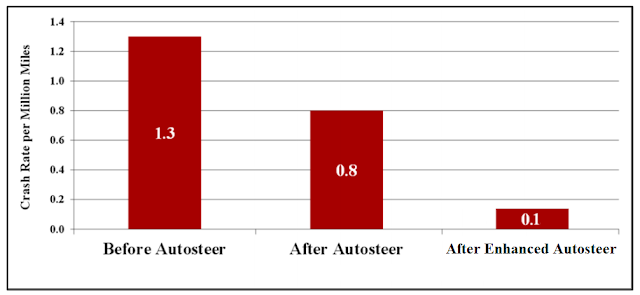Telsa Autopilot 2.0 could be ten times safer than human only driving which could eventually save over 1 million lives per year worldwide
by noreply@blogger.com (brian wang) from NextBigFuture.com on (#29RFE)
Based on actual first year driving data, Tesla vehicles with first generation Autopilot had a crash rate that was 40% less than regular cars without Autopilot.
Elon Musk said that the Autopilot team is aiming for the second generation Autopilot to reduce the crash rate by 90%.
If achieved, it would mean that all of Tesla's vehicles produced since October 2016 would crash on average only once for every ten crashes by vehicles without the advanced driver assist system.
That's 1.3 crash per million miles before Autopilot's Autosteer feature down to 0.8 crash per million miles after Autosteer - a 40% reduction in crash rate verified by NHTSA - and now they are aiming for 0.1 crash per million miles after the introduction of what the company has been calling 'Enhanced Autosteer' with Tesla's second generation Autopilot hardware.
Autopilot 2.0 has more cameras, including a triple front-facing camera setup, and the new vehicles are also now equipped with an onboard supercomputer capable of supporting Tesla Vision, the automaker's new in-house image processing system:


Elon Musk has pledging that by the end of 2017, he'll produce a Tesla that can drive itself from Los Angeles to New York City, no human needed.
Traffic deaths in the United States rose 10.4 percent in the first half of this year compared with the same period in 2015, maintaining a steady climb. The National Highway Traffic Safety Administration noted that Americans drove about 50.5 billion more miles in the first six months of 2016 than in the first half of 2015, an increase of 3.3 percent. But that does not account for the rise in the number of deaths: to 17,775 in the first six months of 2016 from 16,100 in the same period in 2015.
If all cars in the USA had autopilot 2.0 or better driver assistance systems by 2025, then traffic deaths could be reduced to less than 4000 per year instead of 35,000.
There were 1.25 million road traffic deaths globally in 2013.
Read more










Elon Musk said that the Autopilot team is aiming for the second generation Autopilot to reduce the crash rate by 90%.
If achieved, it would mean that all of Tesla's vehicles produced since October 2016 would crash on average only once for every ten crashes by vehicles without the advanced driver assist system.
That's 1.3 crash per million miles before Autopilot's Autosteer feature down to 0.8 crash per million miles after Autosteer - a 40% reduction in crash rate verified by NHTSA - and now they are aiming for 0.1 crash per million miles after the introduction of what the company has been calling 'Enhanced Autosteer' with Tesla's second generation Autopilot hardware.
Autopilot 2.0 has more cameras, including a triple front-facing camera setup, and the new vehicles are also now equipped with an onboard supercomputer capable of supporting Tesla Vision, the automaker's new in-house image processing system:


Elon Musk has pledging that by the end of 2017, he'll produce a Tesla that can drive itself from Los Angeles to New York City, no human needed.
Traffic deaths in the United States rose 10.4 percent in the first half of this year compared with the same period in 2015, maintaining a steady climb. The National Highway Traffic Safety Administration noted that Americans drove about 50.5 billion more miles in the first six months of 2016 than in the first half of 2015, an increase of 3.3 percent. But that does not account for the rise in the number of deaths: to 17,775 in the first six months of 2016 from 16,100 in the same period in 2015.
If all cars in the USA had autopilot 2.0 or better driver assistance systems by 2025, then traffic deaths could be reduced to less than 4000 per year instead of 35,000.
There were 1.25 million road traffic deaths globally in 2013.
Read more